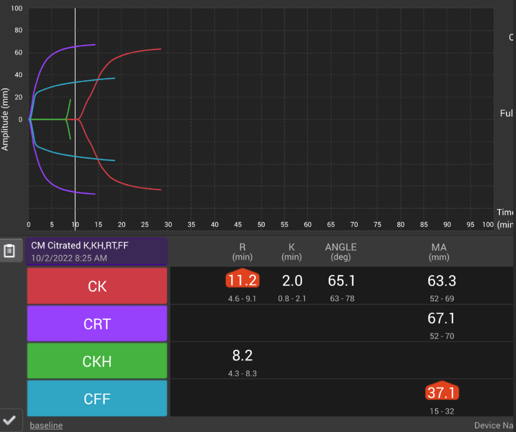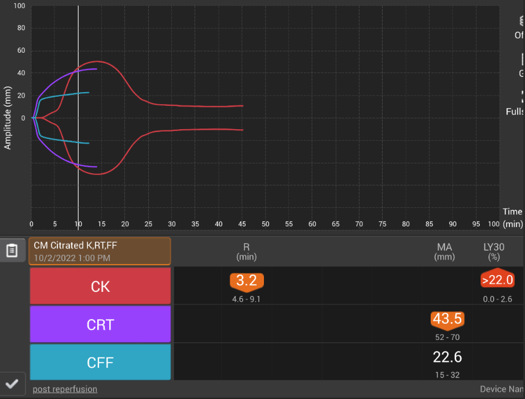A Comprehensive Analysis of Coagulation Dynamics and Clinical Applications
John Bellamente, MD
Published April 18, 2025 | Clinics in Medical Education
Issue 6 | Volume 1 | April 2025
This is a 66 y/o man with alcoholic cirrhosis who presents for combined liver/kidney transplant. Baseline TEG was normal. After reperfusion, the following tracing (Figure 1) was obtained.

What do you notice about this tracing?
Would you give products? What else could you give?

Later on, the surgical team observed worsening oozing from the retroperitoneum.
What should be given here? What if the surgical team asks for more FFP?
The bleeding improves. A few hours later, a repeat TEG (Figure 3) is done as oozing has resumed.

Did our prior therapy work?
What should we do now?
What is Thromboelastography (TEG)?
Traditional coagulation tests do not show the mechanical properties of clot over time because PT and PTT both terminate at low thrombin levels and before fibrin is polymerized. TEG provides a comprehensive view of a hemostatic profile, assessing the hemostatic potential of whole blood, as compared to a traditional coagulation monitoring. TEG measures viscoelasticity of whole blood from initiation of fibrin formation to maximal platelet clot strength and through fibrinolysis.
Which parameters are used to measure clot strength?
TEG measures clot strength over time, focusing on:
- Clot rate (R, in mins) – time it takes for first measurable clot to form.
- Clot strength (max. amplitude MA, in mm) – Strength of the clot.
- Clot stability (lysis LY30, in %): breakdown of the clot.
Graphical tracing and numerical results are reported for each measurement and results are highlighted orange if they fall outside the reference range.
Citrated Kaolin (CK): An intrinsic pathway activated assay identifies underlying hemostatic characteristics and risk of bleeding or thrombosis.
Citrated Kaolin with Heparinase (CKH): Eliminates the effect of heparin in the test sample and used in conjunction with Kaolin assessed the presence of systemic heparin.
Citrated Rapid TEG (CRT): An intrinsic and extrinsic pathway activated assay speeds the coagulation properties.
Citrated Functional Fibrinogen (CFF): Used in conjunction with Kaolin or RapidTEG can assess relative contribution of platelets and fibrin to overall clot strength.


